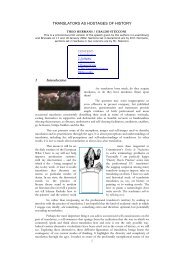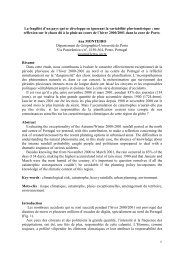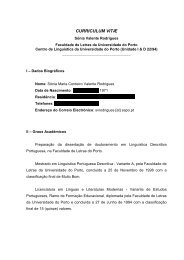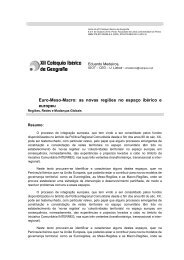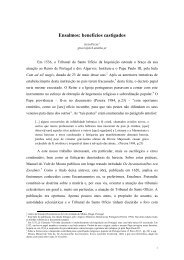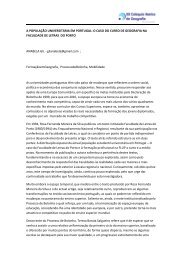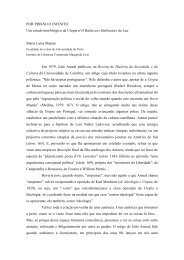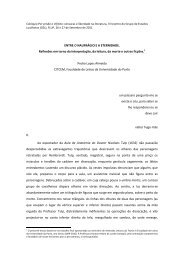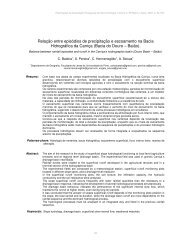Loyalty and Fidelity in Specialized Translation
Loyalty and Fidelity in Specialized Translation
Loyalty and Fidelity in Specialized Translation
Create successful ePaper yourself
Turn your PDF publications into a flip-book with our unique Google optimized e-Paper software.
LOYALTY AND FIDELITY IN SPECIALIZED TRANSLATION<br />
CHRISTIANE NORD 1<br />
Heidelberg, Germany<br />
tradução e localização<br />
Abstract:<br />
The article explores the relationship between functionalism, loyalty <strong>and</strong> fidelity <strong>in</strong><br />
specialized translation. In a first step, it discusses the basic pr<strong>in</strong>ciples of functionalism <strong>in</strong><br />
translation, the first of which (the translation purpose determ<strong>in</strong>es the translation method)<br />
gives rise to a debate on the ethical aspects of functionalism. To make the functionality<br />
concept applicable to translator tra<strong>in</strong><strong>in</strong>g <strong>and</strong> translation practice, the author has<br />
<strong>in</strong>troduced the complementary pr<strong>in</strong>ciple of loyalty, which, unlike faithfulness, or fidelity,<br />
refers to a trustful <strong>and</strong> fair relationship between the persons <strong>in</strong>teract<strong>in</strong>g <strong>in</strong> a translation<br />
process. In the process of loyally produc<strong>in</strong>g a functional translation, the translator may rely<br />
on <strong>in</strong>tertextual relationships between the texts <strong>in</strong> both the source <strong>and</strong> the target culture.<br />
Keywords:<br />
Functionalism; <strong>Loyalty</strong>; <strong>Fidelity</strong>; Ethics; Intertextuality.<br />
Resumo:<br />
O artigo aborda a relação entre a funcionalidade, a lealdade e a fidelidade no âmbito da<br />
tradução especializada. Numa primeira fase, analisa os pr<strong>in</strong>cípios básicos do funcionalismo<br />
aplicado à tradução e o debate ético que é levantado pelo seu primeiro pr<strong>in</strong>cípio, segundo o<br />
1 The author held a chair for translation studies <strong>and</strong> specialized communication at the University<br />
of Applied Sciences of Magdeburg-Stendal (Germany), from which she retired <strong>in</strong> 2005. She is<br />
a research fellow of the University of the Orange Free State (UOFS), Bloemfonte<strong>in</strong> (South<br />
Africa).<br />
C O N F L U Ê N C I A S – R e v i s t a d e T r a d u ç ã o C i e n t í f i c a e T é c n i c a , N . º 4 , M a i o 2 0 0 6 : 2 9 - 4 1<br />
ARTIGOS E COMUNICAÇÕES
tradução e localização<br />
qual a f<strong>in</strong>alidade determ<strong>in</strong>a o método de tradução. Para que o conceito de funcionalidade<br />
seja aplicado à formação e à prática profissional, a autora <strong>in</strong>troduz o pr<strong>in</strong>cípio<br />
complementar da lealdade que, ao contrário da noção de fidelidade, assenta numa relação<br />
justa e de confiança entre as pessoas envolvidas no processo de tradução. De modo a<br />
produzir, lealmente, uma tradução funcional, o tradutor pode basear-se nas relações<br />
<strong>in</strong>tertextuais entre os textos da cultura de partida e da cultura de chegada.<br />
Palavras-Chave:<br />
Funcionalismo: Lealdade; Fidelidade; Ética; Intertextualidade.<br />
1. GENERAL REMARKS<br />
The follow<strong>in</strong>g considerations draw on a functional approach of translation (cf. Nord<br />
1997), based on Skopos theory (cf. Vermeer 1978, Reiss/Vermeer 1984). Skopos is the<br />
Greek word for "aim, purpose", <strong>and</strong> the basic pr<strong>in</strong>ciple of Skopos theory is that the<br />
(<strong>in</strong>tended) purpose of the target text determ<strong>in</strong>es the choice of method <strong>and</strong> strategy <strong>in</strong><br />
the translation process. The target-text purpose is def<strong>in</strong>ed by the translation<br />
commission, or rather: translation brief. In professional sett<strong>in</strong>gs, the "brief" is often not<br />
sufficiently explicit because commissioners are no translation experts <strong>and</strong> therefore<br />
they are not aware of what k<strong>in</strong>d of <strong>in</strong>formation the translator needs to produce a text<br />
that fulfils the needs <strong>and</strong> expectations of the client <strong>and</strong>/or the prospective target-text<br />
audience. Therefore, the first step <strong>in</strong> the translation process is the "<strong>in</strong>terpretation of<br />
the brief", draw<strong>in</strong>g on whatever <strong>in</strong>formation there is or can be obta<strong>in</strong>ed about the<br />
"profile" of the target text the client needs. In rout<strong>in</strong>e tasks from well-known clients,<br />
for example, the translator may rely on previous experience; <strong>in</strong> "st<strong>and</strong>ard briefs" (like<br />
translat<strong>in</strong>g a set of operat<strong>in</strong>g <strong>in</strong>structions for a similar audience to achieve the same<br />
communicative function as that of the source text), they may simply follow the<br />
culture-specific norms for this k<strong>in</strong>d of translation. Any task that is not st<strong>and</strong>ard or<br />
rout<strong>in</strong>e, will have to be specified before the process is <strong>in</strong>itiated, <strong>and</strong> clients have to be<br />
"educated" to provide all sorts of <strong>in</strong>formation or <strong>in</strong>dications available. Otherwise they<br />
will have to take what they get: a target text that fits many functions but none<br />
particularly well – <strong>in</strong>stead of a text that is made to measure for the client's needs.<br />
This does not mean that the client should tell the translator how to go about her or his<br />
work – no less than a client tells a mechanic how to fix the broken car or a lawyer how<br />
to defend the accused. The methods <strong>and</strong> strategies to choose from are part <strong>and</strong> parcel<br />
of the translator's professional competence, <strong>and</strong> this, <strong>in</strong> turn, is the basis for loyalty<br />
<strong>and</strong> trust between the translator <strong>and</strong> her/his <strong>in</strong>teraction partners <strong>in</strong> <strong>in</strong>tercultural<br />
mediation, as we will see below.<br />
ARTIGOS E COMUNICAÇÕES<br />
30
2. BASIC PRINCIPLES OF FUNCTIONALISM IN TRANSLATION<br />
tradução e localização<br />
Functionalist approaches to translation draw on the follow<strong>in</strong>g basic pr<strong>in</strong>ciples:<br />
a) The purpose of the translation determ<strong>in</strong>es the choice of translation method <strong>and</strong><br />
strategy. This means that, as experience shows, there is no s<strong>in</strong>gle method or<br />
strategy for one particular source text, <strong>and</strong> any decision between two or more<br />
available solutions to a translation problem must be guided by some k<strong>in</strong>d of<br />
<strong>in</strong>tersubjective criterion or set of criteria (i.e. strategy). In the case of functional<br />
approaches, this criterion is the communicative function or functions for which<br />
the target text is needed (i.e. the functionality pr<strong>in</strong>ciple).<br />
b) The commissioner or client who needs a translation usually def<strong>in</strong>es the translation<br />
purpose <strong>in</strong> the translation brief. If the translation brief is not sufficiently explicit<br />
(as <strong>in</strong> "Could you please translate this text by Wednesday!"), the translator has to<br />
f<strong>in</strong>d out what k<strong>in</strong>d of purposes the client has <strong>in</strong> m<strong>in</strong>d, rely<strong>in</strong>g on previous<br />
experience <strong>in</strong> similar situations, or <strong>in</strong>terpret<strong>in</strong>g any clues that might <strong>in</strong>dicate the<br />
<strong>in</strong>tended purpose, or ask<strong>in</strong>g clients for more <strong>in</strong>formation about their <strong>in</strong>tended<br />
purpose(s).<br />
c) A translation that achieves the <strong>in</strong>tended purpose may be called functional.<br />
Functionality means that a text (<strong>in</strong> this case: a translation) 'works' for its receivers<br />
<strong>in</strong> a particular communicative situation <strong>in</strong> the way the sender wants it to work. If<br />
the purpose is <strong>in</strong>formation, the text should offer this <strong>in</strong> a form comprehensible to<br />
the audience; if the purpose is to amuse, then the text should actually make its<br />
readers laugh or at least smile. The text producer (<strong>and</strong> the translator as text<br />
producer, too) has, therefore, to evaluate the audience's capacities of<br />
comprehension <strong>and</strong> cooperation <strong>and</strong> anticipate the possible effects which certa<strong>in</strong><br />
forms of expression may have on the readership.<br />
d) Functionality is not an <strong>in</strong>herent quality of a text. It is a quality attributed to the<br />
text by the receiver, <strong>in</strong> the moment of reception. It is the receiver who decides<br />
whether (<strong>and</strong> how) a text 'functions' (for them, <strong>in</strong> a specific situation). If, as we<br />
know, the same receiver at different moments of her/his life reacts <strong>in</strong> different<br />
ways to the 'same' text (e.g. Shakespeare's Romeo <strong>and</strong> Juliet), it is most<br />
improbable that different readers at different moments, let alone readers<br />
belong<strong>in</strong>g to different cultural environments, will react to the same text <strong>in</strong> the<br />
same manner.<br />
e) But if this is true, how can we be sure that a text achieves the function we want it<br />
to achieve? We cannot. Usually we rely on the audience's will<strong>in</strong>gness to cooperate<br />
<strong>in</strong> a given situation, otherwise communication would be impossible. Any text<br />
producer, therefore, consciously or unconsciously uses some k<strong>in</strong>d of verbal <strong>and</strong>/or<br />
non-verbal 'function markers' <strong>in</strong>dicat<strong>in</strong>g the <strong>in</strong>tended communicative function(s),<br />
e.g., pr<strong>in</strong>t<strong>in</strong>g the text <strong>in</strong> small letters on a slip of paper that comes with a box of<br />
pills, which <strong>in</strong>dicates a patient package <strong>in</strong>sert. Impos<strong>in</strong>g a title like 'Instructions for 31<br />
ARTIGOS E COMUNICAÇÕES
The methods <strong>and</strong><br />
strategies to choose from<br />
are part <strong>and</strong> parcel of the<br />
translator's professional<br />
competence, <strong>and</strong> this,<br />
<strong>in</strong> turn, is the basis for<br />
loyalty <strong>and</strong> trust between<br />
the translator <strong>and</strong> her/his<br />
<strong>in</strong>teraction partners <strong>in</strong><br />
<strong>in</strong>tercultural mediation<br />
tradução e localização<br />
use', to mention just another example, is a most explicit <strong>in</strong>dication that the sender<br />
wants this text to function as an <strong>in</strong>struction. Other types of markers: a particular<br />
text format or lay-out, say, a newspaper headl<strong>in</strong>e; certa<strong>in</strong> sentence structures, say,<br />
imperatives <strong>in</strong> a recipe; a particular register, as <strong>in</strong> an editorial; certa<strong>in</strong> forms of<br />
address for the readership, say, <strong>in</strong> a student’s manual, etc. If the receivers<br />
recognise the function markers, they may accept the text as serv<strong>in</strong>g the <strong>in</strong>tended<br />
function. But markers can only be <strong>in</strong>terpreted correctly by a receiver who is<br />
familiar with the ‘marker code’ that is used.<br />
f) One of the most important text-produc<strong>in</strong>g strategies is to f<strong>in</strong>d the appropriate<br />
balance between new <strong>and</strong> old <strong>in</strong>formation; if a text offers too much new<br />
<strong>in</strong>formation it will be <strong>in</strong>comprehensible for the readers, while if it conta<strong>in</strong>s too<br />
little new <strong>in</strong>formation, the audience will not f<strong>in</strong>d it worth read<strong>in</strong>g.<br />
g) Especially <strong>in</strong> the case of texts translated from a source culture that is<br />
distant <strong>in</strong> time <strong>and</strong>/or space from the target-cultural environment, the<br />
function (or hierarchy of functions) <strong>in</strong>tended for, <strong>and</strong>/or achieved by, the<br />
target text may be different from that <strong>in</strong>tended for, <strong>and</strong>/or achieved by, the<br />
source text.<br />
3. LOYALTY AS A CORRECTIVE IN FUNCTIONAL TRANSLATION<br />
Look<strong>in</strong>g at these basic pr<strong>in</strong>ciples we may wonder why there is no mention of criteria<br />
like ‘faithfulness’ or ‘fidelity’, which have been almost sacrosanct <strong>in</strong> any discourse on<br />
translation for the past two thous<strong>and</strong> years. This is the reason why some critics<br />
reproach functionalism for produc<strong>in</strong>g "mercenary experts, able to fight under the flag<br />
of any purpose able to pay them" (Pym 1996: 338). Others hold the view that a<br />
translator who takes <strong>in</strong>to account the needs <strong>and</strong> expectations of her/his target<br />
audience must necessarily lose sight of 'the' source text.<br />
The latter criticism can be answered on the grounds of the concept of ‘text’ as used <strong>in</strong><br />
functional translation theory. In terms of what I have said about functional markers<br />
<strong>and</strong> their culture-specificity, the form <strong>in</strong> which the source text presents itself to the<br />
translator is a product of the many variables of the situation (time, place, medium,<br />
addressees) <strong>in</strong> which it orig<strong>in</strong>ated, while the way this form is <strong>in</strong>terpreted <strong>and</strong><br />
understood by the translator, or any other receiver, is guided by the variables of the<br />
new situation of reception.<br />
The first criticism refers to an ethical quality related to the status of the source text.<br />
While the broader, text-l<strong>in</strong>guistic, equivalence approach stretches the idea of a<br />
translation's double l<strong>in</strong>kage to both the source <strong>and</strong> target sides (sometimes so far as to<br />
blur the borderl<strong>in</strong>e between translations <strong>and</strong> non-translations), narrower l<strong>in</strong>guistic<br />
approaches still start from the autonomy or authority of a source text, that must not<br />
be touched <strong>in</strong> the translation process. In Skopostheorie, however, the source texts, or 32<br />
ARTIGOS E COMUNICAÇÕES
tradução e localização<br />
more precisely, its l<strong>in</strong>guistic <strong>and</strong> stylistic features, are no longer regarded as the<br />
yardstick for a translation. Does this mean that the translator is entitled to do as he or<br />
she likes with the source text?<br />
Indeed, the first basic pr<strong>in</strong>ciple of functionalism could be paraphrased as ‘the<br />
translation purpose justifies the translation procedures’, <strong>and</strong> this sounds very much like<br />
‘the end justifies the means’. As such, there would be no restriction to the range of<br />
possible ends; the source text could be manipulated as clients (or translators) saw fit.<br />
In a general theory, this doctr<strong>in</strong>e might be acceptable enough, s<strong>in</strong>ce one could always<br />
argue that general theories do not have to be directly applicable. Yet translation<br />
practice does not take place <strong>in</strong> a void. It takes place <strong>in</strong> specific situations set <strong>in</strong> specific<br />
cultures, so any application of the general theory, either to practice or to tra<strong>in</strong><strong>in</strong>g, has<br />
to consider the specific cultural conditions under which a text is translated.<br />
At different times <strong>and</strong> <strong>in</strong> different parts of the world, people have had <strong>and</strong> still have<br />
different concepts of the relationship that should hold between an orig<strong>in</strong>al <strong>and</strong> the<br />
text that is called its translation. Accord<strong>in</strong>g to the prevail<strong>in</strong>g concept of translation,<br />
readers might expect, for example, the target text to give the author's op<strong>in</strong>ion exactly;<br />
other cultures might want it to be a faithful reproduction of the formal features of the<br />
source text; still others could praise archais<strong>in</strong>g translations or ones that are far from<br />
faithful reproductions, but comprehensible, readable texts. Tak<strong>in</strong>g account of all these<br />
different expectations, which may vary accord<strong>in</strong>g to the text type <strong>in</strong> question or<br />
depend on the self-esteem of the receiv<strong>in</strong>g culture with regard to the source culture,<br />
the translator acts as a responsible mediator <strong>in</strong> the cooperation develop<strong>in</strong>g between<br />
the client, the target audience <strong>and</strong> the source-text author. This does not mean that<br />
translators always have to do what the other parties expect, which may even be<br />
impossible if the three parties expect different translational behaviours. It means that<br />
the translator has to anticipate any misunderst<strong>and</strong><strong>in</strong>g or communicative conflict that<br />
may occur due to different translational concepts <strong>and</strong> f<strong>in</strong>d a way to avoid them.<br />
The responsibility that translators have toward their partners is what I call 'loyalty'. The<br />
loyalty pr<strong>in</strong>ciple was first <strong>in</strong>troduced <strong>in</strong>to Skopostheorie <strong>in</strong> 1989 (Nord 1989, cf. Nord<br />
1997: 123 ff.) <strong>in</strong> order to account for the culture-specificity of translation concepts,<br />
sett<strong>in</strong>g an ethical limitation on the otherwise unlimited range of possible skopoi for<br />
the translation of one particular source text. It was argued that translators, <strong>in</strong> their<br />
role as mediators between two cultures, have a special responsibility with regard to<br />
their partners, i.e. the source-text author, the client or commissioner of the translation,<br />
<strong>and</strong> the target-text receivers, <strong>and</strong> towards themselves, precisely <strong>in</strong> those cases where<br />
there are differ<strong>in</strong>g views as to what a 'good' translation is or should be. As an<br />
<strong>in</strong>terpersonal category referr<strong>in</strong>g to a social relationship between people who expect<br />
not to be cheated <strong>in</strong> the process, loyalty may replace the traditional <strong>in</strong>tertextual<br />
relationship of 'fidelity', a concept that usually refers to a l<strong>in</strong>guistic or stylistic<br />
similarity between the source <strong>and</strong> the target texts, regardless of the communicative<br />
<strong>in</strong>tentions <strong>and</strong>/or expectations <strong>in</strong>volved. It is the translator's task to mediate between<br />
ARTIGOS E COMUNICAÇÕES<br />
33
This confidence will<br />
then strengthen the<br />
translator's social<br />
prestige as a<br />
responsible <strong>and</strong><br />
trustworthy partner.<br />
tradução e localização<br />
the two cultures, <strong>and</strong> I believe that mediation can never mean the imposition of the<br />
concept of one culture on the members of another.<br />
In <strong>in</strong>troduc<strong>in</strong>g the loyalty pr<strong>in</strong>ciple <strong>in</strong>to the functionalist model, I would therefore also<br />
hope to lay the foundations for a trust<strong>in</strong>g relationship between the partners <strong>in</strong> the<br />
translational <strong>in</strong>teraction. If authors can be sure that translators will respect their<br />
communicative <strong>in</strong>terests or <strong>in</strong>tentions, they may even consent to any changes or<br />
adaptations needed to make the translation work <strong>in</strong> the target culture. And if clients or<br />
receivers can be sure that the translator will consider their communicative needs as<br />
well, they may even accept a translation that is different from what they had expected.<br />
This confidence will then strengthen the translator's social prestige as a responsible<br />
<strong>and</strong> trustworthy partner.<br />
The loyalty pr<strong>in</strong>ciple thus adds two important qualities to the functional approach.<br />
S<strong>in</strong>ce it obliges the translator to take account of the difference between culturespecific<br />
concepts of translation prevail<strong>in</strong>g <strong>in</strong> the two cultures (<strong>in</strong>volved <strong>in</strong> the<br />
translation process), it turns Skopostheorie <strong>in</strong>to an anti-universalist model; <strong>and</strong> s<strong>in</strong>ce it<br />
<strong>in</strong>duces the translator to respect the sender's <strong>in</strong>dividual communicative <strong>in</strong>tentions, as<br />
far as they can be elicited, it reduces the prescriptiveness of 'radical' functionalism.<br />
The follow<strong>in</strong>g example may illustrate this po<strong>in</strong>t.<br />
In 1972, Ernesto Cardenal published a book with the title En Cuba ("In Cuba",<br />
Cardenal 1972a), <strong>in</strong> which he enthusiastically described how wonderful he found<br />
the “new” Cuba under Fidel Castro. Immediately after its publication <strong>in</strong> Spanish,<br />
the book was translated <strong>in</strong>to German (Cardenal 1972b). The West German<br />
publisher asked the translator to adjust the author’s Lat<strong>in</strong> American “pathetic<br />
style” to what they considered acceptable for a West German audience – precisely<br />
<strong>in</strong> connection with a communist system dur<strong>in</strong>g the Cold War period. Consequently,<br />
the translator omitted, or at least, toned down most of the author’s positive<br />
evaluative <strong>and</strong> emotional utterances with regard to post-revolutionary Cuba, Fidel<br />
Castro or the Cuban Revolution, <strong>and</strong> his negative remarks about the United States<br />
<strong>and</strong> their representatives, e.g. the US ambassador. She omitted, for example, the<br />
dedication 'Al pueblo cubano y a Fidel' (To the Cuban people <strong>and</strong> to Fidel), Che<br />
Guevara’s motto 'Todos parejos en todo' (All equal <strong>in</strong> everyth<strong>in</strong>g), the<br />
characterization 'con su cara de cerdo' (with his pigface) <strong>in</strong> the description of<br />
dictator Batista, the remark that black people work like slaves <strong>in</strong> the United States<br />
('trabajan como esclavos en los Estados Unidos'), three pages of testimonies about<br />
torture <strong>and</strong> acts of violence of the Batista regime, <strong>and</strong> a whole paragraph <strong>in</strong> which<br />
Fidel Castro expla<strong>in</strong>s <strong>in</strong> verbatim his vision of a socialist society <strong>in</strong> Cuba <strong>in</strong> an<br />
<strong>in</strong>terview with the author (cf. Grohmann 1976: 31-33). S<strong>in</strong>ce this was Ernesto<br />
Cardenal’s first book ever to be published <strong>in</strong> Germany, German readers received the<br />
impression that he was a journalist describ<strong>in</strong>g his visit to Cuba <strong>in</strong> a rather<br />
detached, "objective" k<strong>in</strong>d of style.<br />
ARTIGOS E COMUNICAÇÕES<br />
34
tradução e localização<br />
The first basic pr<strong>in</strong>ciple of functional translation theory mentioned above should,<br />
therefore, be restricted <strong>in</strong> the sense that the range of acceptable translation purposes<br />
is limited by the translator's responsibility to all her/his partners <strong>in</strong> the cooperative<br />
activity of translation (i.e. the loyalty pr<strong>in</strong>ciple). <strong>Loyalty</strong> may oblige translators to reveal<br />
their translation purposes <strong>and</strong> justify their translational decisions.<br />
In what follows, I will look at loyalty from four different angles: loyalty <strong>and</strong> conflict<br />
prevention, loyalty <strong>and</strong> professionality, loyalty <strong>and</strong> trust, loyalty <strong>and</strong> fairness.<br />
3.1. <strong>Loyalty</strong> <strong>and</strong> conflict prevention<br />
If we consider translation to be an activity facilitat<strong>in</strong>g communication between people<br />
belong<strong>in</strong>g to different language <strong>and</strong> culture communities, the translator is part of a<br />
communicative <strong>in</strong>teraction <strong>in</strong>tended to overcome l<strong>in</strong>guistic <strong>and</strong> cultural boundaries<br />
between people. Such an <strong>in</strong>teraction <strong>in</strong>volves at least four participants or, rather, roles:<br />
• the source-culture sender (SC-S) of a message which was produced for a sourceculture<br />
audience (SC-A) <strong>in</strong> order to achieve a particular communicative purpose <strong>in</strong><br />
the source culture (SC-P);<br />
• a client or <strong>in</strong>itiator (INI), who commissions a translation or <strong>in</strong>terpretation of this<br />
source-culture message for a target-culture audience (TC-A) <strong>in</strong> order to achieve a<br />
particular communicative purpose (TC-P);<br />
• a translator or <strong>in</strong>terpreter (TRL), who produces the target text accord<strong>in</strong>g to the way<br />
<strong>in</strong> which the <strong>in</strong>itiator specifies the commission (possibly <strong>in</strong> a translation brief);<br />
• the target-text receivers (TC-R), whose reception is guided by their own<br />
communicative needs plus the verbal <strong>and</strong> nonverbal function markers found <strong>in</strong> the<br />
text <strong>and</strong> <strong>in</strong> the situation <strong>in</strong> which it is received, <strong>in</strong> addition to their expectations<br />
toward a text received <strong>in</strong> such a situation.<br />
While the sender <strong>and</strong> the receivers belong to the source <strong>and</strong> the target culture,<br />
respectively, the <strong>in</strong>itiator <strong>and</strong> the translator can be members of either the source or the<br />
target culture. The behaviour of each of these participants is guided by their respective<br />
socio-cultural backgrounds, by culture-specific norms <strong>and</strong> conventions <strong>and</strong> by their<br />
subjective (<strong>in</strong> the case of sender, <strong>in</strong>itiator <strong>and</strong> receivers) or objective (<strong>in</strong> the case of the<br />
translator if she/he has undergone formal tra<strong>in</strong><strong>in</strong>g) theories on translation.<br />
In this <strong>in</strong>tercultural communicative <strong>in</strong>teraction, the translator is the only one who is<br />
(by def<strong>in</strong>ition) familiar with the conditions <strong>and</strong> norms of both the source <strong>and</strong> the<br />
target cultures, while the other participants are often not even aware of those of their<br />
own culture <strong>in</strong> contrast with the others. Each of them communicates (as a sender or an<br />
<strong>in</strong>itiator or a receiver) accord<strong>in</strong>g to the conditions of her/his own culture. Due to their<br />
familiarity with both cultures, only translators are <strong>in</strong> a position to discover the conflict<br />
potentials (Michael Agar calls them "rich po<strong>in</strong>ts", 1991: 168) <strong>and</strong> either avoid them or<br />
ARTIGOS E COMUNICAÇÕES<br />
35
tradução e localização<br />
f<strong>in</strong>d a satisfactory solution. Therefore, translators play a powerful role. They could<br />
easily deceive their partners without anybody notic<strong>in</strong>g - sometimes just by "faithfully"<br />
translat<strong>in</strong>g what the source text says.<br />
For this k<strong>in</strong>d of conflict management, ethical pr<strong>in</strong>ciples are needed. For we have to ask<br />
whose expectations will have priority <strong>in</strong> the case of <strong>in</strong>compatibility. A translator who is<br />
"loyal" should make sure that <strong>in</strong> this <strong>in</strong>teraction none of the participants is deceived or<br />
otherwise damaged. Chesterman (1997: 184 ff. <strong>and</strong> 2001: 151-152) speaks of<br />
prevention or reduction of "communicative suffer<strong>in</strong>g":<br />
Communicative suffer<strong>in</strong>g arises from not underst<strong>and</strong><strong>in</strong>g someth<strong>in</strong>g that<br />
you want to underst<strong>and</strong>, from misunderst<strong>and</strong><strong>in</strong>g or <strong>in</strong>adequate<br />
underst<strong>and</strong><strong>in</strong>g, <strong>and</strong> from not be<strong>in</strong>g able to get your own message across.<br />
It also arises from a lack of communication at all. Translators are like<br />
doctors <strong>in</strong> that their task is to <strong>in</strong>tervene <strong>in</strong> certa<strong>in</strong> cases of<br />
communicative suffer<strong>in</strong>g: those <strong>in</strong>volv<strong>in</strong>g language <strong>and</strong> culture<br />
boundaries. (Chesterman 2001: 151)<br />
As everybody knows, physiological <strong>and</strong> psychological suffer<strong>in</strong>g can also be caused by<br />
deficiencies we are not aware of. A doctor act<strong>in</strong>g <strong>in</strong> an ethical way will therefore not<br />
only cure the symptoms the patient is compla<strong>in</strong><strong>in</strong>g about but also try to discover the<br />
orig<strong>in</strong> of the illness <strong>and</strong> look for a remedy. The translator is such a doctor who tries to<br />
prevent communicative suffer<strong>in</strong>g by responsible <strong>and</strong> professional procedures. This<br />
becomes obvious <strong>in</strong> cases where old texts belong<strong>in</strong>g to the cultural heritage – like the<br />
Bible or the works of Shakespeare – are re-translated. Receivers may not recognize<br />
certa<strong>in</strong> passages they know by heart or allusions to, or quotations of, well-known<br />
words <strong>and</strong> phrases (even though they may not even be able to expla<strong>in</strong> their mean<strong>in</strong>g).<br />
3.2. <strong>Loyalty</strong> <strong>and</strong> Professionalism<br />
Unlike that of doctors or lawyers, the translator's professional title is not legally<br />
protected. <strong>Translation</strong> services can be offered by anybody who feels capable or entitled<br />
to do so, although an error <strong>in</strong> a translation or <strong>in</strong>terpretation can cause as much<br />
damage to people <strong>and</strong> objects as wrong medical treatment or wrong legal advice.<br />
Therefore, an ethics of translation must <strong>in</strong>clude the obligation to act <strong>in</strong> a professional<br />
way.<br />
Professionalism means that the translator has the competences required for translation<br />
or <strong>in</strong>terpret<strong>in</strong>g services <strong>and</strong> constantly tries to improve them; it means that she/he is<br />
"striv<strong>in</strong>g for excellence", as Chesterman puts it (2001: 149). The “Code of Professional<br />
Conduct <strong>and</strong> Bus<strong>in</strong>ess Practices” of the American Translators' Association, published <strong>in</strong><br />
November 1997 (ATA 1997), lists the follow<strong>in</strong>g abilities required of a professional<br />
translator: 36<br />
ARTIGOS E COMUNICAÇÕES
tradução e localização<br />
• mastery of the target language equivalent to that of an educated native speaker;<br />
• up-to-date knowledge of the subject material <strong>and</strong> its term<strong>in</strong>ology <strong>in</strong> both<br />
languages;<br />
• access to <strong>in</strong>formation resources <strong>and</strong> reference materials, <strong>and</strong> knowledge of the tools<br />
of the profession.<br />
In addition, professional translators must be able to consider the possible<br />
consequences of their translational actions, keep their partners from gett<strong>in</strong>g damaged<br />
<strong>and</strong> try to avoid negative consequences. This is an ability no person is born with, so it<br />
has to be developed <strong>in</strong> the course of tra<strong>in</strong><strong>in</strong>g, where the future translator receives an<br />
education about the theoretical <strong>and</strong> methodological foundations of translation<br />
practice.<br />
professional translators<br />
3.3. <strong>Loyalty</strong> <strong>and</strong> trust<br />
must be able to consider<br />
the possible consequences<br />
of their translational Com<strong>in</strong>g back to example 1, I may state that both the Nicaraguan author <strong>and</strong><br />
actions, keep their partners the German readers have been deceived because the translator fulfilled the<br />
from gett<strong>in</strong>g damaged<br />
requirements of the translation brief. Could we say, therefore, that act<strong>in</strong>g<br />
<strong>and</strong> try to avoid negative<br />
consequences.<br />
accord<strong>in</strong>g to the brief is unethical? Is a translator obliged to critically<br />
This is an ability no person scrut<strong>in</strong>ize a translation brief? Would her behaviour have been "more ethical"<br />
is born with<br />
if she had not done what the publisher had asked her to do? In this case, the<br />
commissioner belonged to the target culture, <strong>and</strong> he could have asked a<br />
reviser to "adjust" the translation to target-culture style conventions – although this<br />
procedure would have shifted the problem of loyalty only to somebody else without<br />
solv<strong>in</strong>g it. However, if the commissioner had been a member of the source culture he<br />
would not have been able to control whether the target text had conformed to his<br />
brief. In any case, the client must always trust the translator.<br />
The same applies to the author <strong>and</strong> the target receivers. As they do not know the other<br />
culture (<strong>in</strong>clud<strong>in</strong>g language) they must rely on the translator’s trustworth<strong>in</strong>ess. The<br />
sender expects the translator to respect his communicative <strong>in</strong>tentions; the receivers<br />
expect to read a translation that corresponds to their expectations, <strong>in</strong> this case: a<br />
translation that gives an idea of the author’s attitude toward the object of reference,<br />
post-revolutionary Cuba.<br />
What could the translator have done to solve the dilemma? One possibility would have<br />
been to discuss the brief with the publisher, agree<strong>in</strong>g perhaps on an explanatory<br />
foreword which would have expla<strong>in</strong>ed the difference between Lat<strong>in</strong> American <strong>and</strong><br />
German style conventions <strong>and</strong> the author’s political st<strong>and</strong>po<strong>in</strong>t. Another possibility<br />
would have been to use target-cultural markers of expressivity without hid<strong>in</strong>g the<br />
author’s op<strong>in</strong>ion.<br />
ARTIGOS E COMUNICAÇÕES<br />
37
tradução e localização<br />
<strong>Loyalty</strong> does not mean that the translator always has to act accord<strong>in</strong>g to her/his<br />
partners‘ expectations, otherwise no translation could have an <strong>in</strong>novative, enrich<strong>in</strong>g<br />
<strong>in</strong>fluence on the target literature or culture.<br />
3.4. <strong>Loyalty</strong> <strong>and</strong> fairness<br />
The fourth item <strong>in</strong> Andrew Chesterman’s suggestion for a "Hieronymic Oath" reads as<br />
follows: "I swear that my translations will not represent their source text <strong>in</strong> unfair<br />
ways." (Chesterman 2001: 153) This "fairness", <strong>in</strong> the sense of be<strong>in</strong>g “free from<br />
dishonesty or <strong>in</strong>justice” (DCE 1978), is also one aspect of loyalty. It means that the<br />
translator refra<strong>in</strong>s from deceiv<strong>in</strong>g any one of the partners <strong>in</strong>volved <strong>in</strong> the translation<br />
process. The aim is to establish a fair relationship between the source-text sender <strong>and</strong><br />
the target-text receivers, without tak<strong>in</strong>g sides <strong>and</strong> without detriment to one or the<br />
other. However, readers <strong>and</strong> clients or senders will only accept the translator’s<br />
behaviour as be<strong>in</strong>g fair if they trust her/him <strong>and</strong> believe <strong>in</strong> her/his honesty <strong>and</strong><br />
professionalism. Therefore, the aspects of loyalty we have dealt with are <strong>in</strong>tr<strong>in</strong>sically<br />
l<strong>in</strong>ked <strong>and</strong> <strong>in</strong>terwoven.<br />
4. INTERTEXTUALITY AS A KEY CONCEPT IN FUNCTIONAL AND LOYAL TRANSLATION<br />
All the texts that were ever written or spoken <strong>in</strong> a particular culture form a culturespecific<br />
repertoire. Among them we can observe various k<strong>in</strong>ds of relationship: genre<br />
relations between all the texts belong<strong>in</strong>g to one particular genre as opposed to those<br />
form<strong>in</strong>g part of other genres; time-related l<strong>in</strong>ks between all the texts produced <strong>in</strong> a<br />
particular moment <strong>in</strong> time as opposed to those produced earlier or later; register<br />
relations between all the texts represent<strong>in</strong>g a specific register, <strong>and</strong> so on. These<br />
<strong>in</strong>tertextual relations of the source <strong>and</strong> the target text are represented <strong>in</strong> Fig. 1.<br />
Whatever its purpose, a translated text is bound to enter the target-culture repertoire<br />
<strong>and</strong> become a part of the culture-specific <strong>in</strong>tertextuality system. There, it might be<br />
supposed to conform to a particular text class or genre or to represent certa<strong>in</strong> register<br />
or time-specific features. In some cultures, translated texts (or, possibly, all texts<br />
translated from a particular source language as opposed to those translated from other<br />
source languages) may form a set of their own <strong>and</strong> show certa<strong>in</strong> typical features<br />
(maybe of "translationese") which are not found <strong>in</strong> non-translated texts. These<br />
features, such as explicitation or shifts, are analysed by corpus-based <strong>Translation</strong><br />
Studies.<br />
ARTIGOS E COMUNICAÇÕES<br />
38
Fig. 1. Intertextuality <strong>in</strong> translation<br />
tradução e localização<br />
Look<strong>in</strong>g at Fig. 1, we see that both the source <strong>and</strong> the target text form part of a system<br />
of <strong>in</strong>tertextual relationships. This means that the effect of the target text can be<br />
predicted compar<strong>in</strong>g it to the (possible, normal, usual) effects of exist<strong>in</strong>g texts from the<br />
target culture. If the text conforms to conventional patterns of a particular class of<br />
texts, the text form will not attract the readers' attention, which allows for an easier<br />
process<strong>in</strong>g of the <strong>in</strong>formation conta<strong>in</strong>ed <strong>in</strong> the text. On the other h<strong>and</strong>, if a text shows<br />
strange, unconventional form patterns, the audience may wonder why the author<br />
chose these orig<strong>in</strong>al forms <strong>and</strong> whether they are meant to convey an extra amount of<br />
<strong>in</strong>formation.<br />
In a translation, for example, where the translation brief requires the target text to<br />
show features of "strangeness" (which I call a documentary translation, cf. Nord 1997:<br />
48 ff.), the purpose would be precisely not to resemble any text exist<strong>in</strong>g <strong>in</strong> the targetculture<br />
repertoire, which makes process<strong>in</strong>g more difficult (<strong>and</strong> maybe also more<br />
mean<strong>in</strong>gful) for the readers. Whereas, <strong>in</strong> an <strong>in</strong>strumental translation (cf. Nord 1997:<br />
50 ff.), the expectation is that the target text fits nicely <strong>in</strong>to the target-culture text<br />
class or genre it is supposed to belong to. In any case, the translator will have to be<br />
familiar with the specificities of the target-culture repertoire to be able to achieve or<br />
avoid conventional <strong>in</strong>tertextual relations <strong>and</strong>/or to predict the audience's reaction,<br />
adjust<strong>in</strong>g her/his strategy accord<strong>in</strong>gly.<br />
5. LOYALTY AND FIDELITY IN SPECIALIZED TRANSLATION<br />
There is no general rule or norm tell<strong>in</strong>g the translator whether to choose a<br />
documentary or an <strong>in</strong>strumental strategy. It depends on the translation brief – but<br />
there are rout<strong>in</strong>e or st<strong>and</strong>ard briefs which might guide the translator's decision if the<br />
brief does not specify any exception from the st<strong>and</strong>ard. This applies both for<br />
specialized <strong>and</strong> non-specialized (e.g. general, literary, biblical) translation tasks.<br />
For many official documents (like marriage certificates or school reports), the "st<strong>and</strong>ard<br />
brief" requires a translation <strong>in</strong> the documentary mode. Here, equivalence is not the<br />
ARTIGOS E COMUNICAÇÕES<br />
39
tradução e localização<br />
purpose, s<strong>in</strong>ce a translated driv<strong>in</strong>g license, for example, is not, as such, a target-culture<br />
document. Rather, it is a "meta-document" giv<strong>in</strong>g evidence, <strong>in</strong> the target language, of,<br />
or <strong>in</strong>form<strong>in</strong>g about, a source-culture document. With regard to <strong>in</strong>tertextuality, this<br />
document will not conform to target-culture patterns of the genre unless these are<br />
identical with those of the source culture. In this case, the outcome of a loyal<br />
translation process will be a faithful translation.<br />
On the other h<strong>and</strong>, where the purpose of specialized translation is the transfer of<br />
<strong>in</strong>formation (as <strong>in</strong> technical texts, product documentation, operat<strong>in</strong>g <strong>in</strong>structions,<br />
balance sheets, etc.), an <strong>in</strong>strumental translation is required, which will not necessarily<br />
reproduce source-culture style or behaviour patterns. In this case, the adaptation of<br />
text forms to target-culture norms <strong>and</strong> conventions will make process<strong>in</strong>g easier for the<br />
receivers, because they are not confronted with style or behaviour patterns they are<br />
not familiar with <strong>and</strong> which sometimes st<strong>and</strong> <strong>in</strong> the way of fast <strong>and</strong> efficient<br />
<strong>in</strong>formation process<strong>in</strong>g.<br />
<strong>Loyalty</strong> always refers to<br />
the attitude or behaviour of<br />
the translator dur<strong>in</strong>g the<br />
process of translation.<br />
6. CONCLUSION<br />
A text or a translation<br />
cannot be loyal. It is the<br />
translator's behaviour Seen <strong>in</strong> this way, loyalty towards people is a category that is entirely<br />
that is or is not loyal different from fidelity to a text. We cannot speak of a "loyal" translation<br />
referr<strong>in</strong>g to the result of the process, the target text. <strong>Loyalty</strong> always refers to<br />
the attitude or behaviour of the translator dur<strong>in</strong>g the process of translation. A text or a<br />
translation cannot be loyal. It is the translator's behaviour that is or is not loyal.<br />
Therefore, loyalty, as was mentioned before, is an <strong>in</strong>terpersonal category affect<strong>in</strong>g the<br />
relationship between people (even though perhaps the author of the source-text is no<br />
longer alive, or some readers will read the target text long after the translator has<br />
died). But act<strong>in</strong>g loyally with regard to the communication partners <strong>in</strong> a specific<br />
translation task <strong>and</strong> with regard to one's own ethical pr<strong>in</strong>ciples does not automatically<br />
mean that the translator gives target-culture norms priority over source-culture norms.<br />
In certa<strong>in</strong> tasks, such as the "st<strong>and</strong>ard" translation of legal documents (like a marriage<br />
certificate or a driv<strong>in</strong>g license) or "st<strong>and</strong>ard" court <strong>in</strong>terpret<strong>in</strong>g, it may mean that some<br />
source-text features are faithfully reproduced <strong>in</strong> the target text.<br />
Therefore, the criticism that functional translators are adaptors, is a generalization that<br />
is supported neither by Skopostheorie nor by the applied functionalist versions of the<br />
theory. The criticism that translators are "mercenary experts", or slaves act<strong>in</strong>g as they<br />
are told by their clients, does not hold water either. On the contrary, the functionalist<br />
approach makes a po<strong>in</strong>t of regard<strong>in</strong>g translators as responsible agents <strong>in</strong> an <strong>in</strong>teraction<br />
between equals, negotiat<strong>in</strong>g, if necessary, the conditions of cultural mediation. One of<br />
the means to this aim is the observation of the pr<strong>in</strong>ciple of loyalty. ■<br />
ARTIGOS E COMUNICAÇÕES<br />
40
7. REFERENCES<br />
tradução e localização<br />
Agar, Michael. “The Biculture <strong>in</strong> Bil<strong>in</strong>gual.” Language <strong>in</strong> Society 20 (1991): 167-181.<br />
ATA. 1997. “Code of Professional Conduct <strong>and</strong> Bus<strong>in</strong>ess Practices.” [On l<strong>in</strong>e]. American<br />
Translators Association. Consulted on May, 2006. Available at .<br />
Cardenal, Ernesto. En Cuba. Buenos Aires: Ediciones Carlos Lohlé, 1972.<br />
Cardenal, Ernesto. In Kuba. Bericht von e<strong>in</strong>er Reise. Translated by A. Schwarzer. Wuppertal: Peter<br />
Hammer, 1972.<br />
Chesterman, Andrew. Memes of <strong>Translation</strong>. Amsterdam: Benjam<strong>in</strong>s, 1997.<br />
Chesterman, Andrew. “Proposal for a Hieronymic Oath.” The Translator 7, no. 2 (2001): 139-154.<br />
DCE. Dictionary of Contemporary English. London: Longman-Langenscheidt, 1978.<br />
Grohmann, Sab<strong>in</strong>e. Übersetzungskritik zu Ernesto Cardenal: En Cuba. Unpublished Diploma<br />
thesis. Heidelberg: Heidelberg University, 1976.<br />
Koller, Werner (1992): E<strong>in</strong>führung <strong>in</strong> die Übersetzungswissenschaft. 4th, rev. edition, Heidelberg:<br />
Quelle & Meyer.<br />
Nord, Christiane. “Loyalität statt Treue. Vorschläge zu e<strong>in</strong>er funktionalen Übersetzungstypologie.”<br />
Lebende Sprachen XXXIV, no. 3 (1989): 100-105.<br />
Nord, Christiane (1997): Translat<strong>in</strong>g as a Purposeful Activity. Functionalist Approaches Expla<strong>in</strong>ed.<br />
Manchester: St. Jerome.<br />
Pym, Anthony (1996): Material Text Transfer as a Key to the Purposes of <strong>Translation</strong>, <strong>in</strong> Neubert,<br />
Albrecht / Shreve, Gregory / Gommlich, Klaus (eds.): Basic Issues <strong>in</strong> <strong>Translation</strong> Studies.<br />
Proceed<strong>in</strong>gs of the Fifth <strong>in</strong>ternational Conference Kent Forum on <strong>Translation</strong> Studies II,<br />
Kent/Ohio: Institute of Applied L<strong>in</strong>guistics, 337-346.<br />
Toury, Gideon. Descriptive <strong>Translation</strong> Studies <strong>and</strong> Beyond. Amsterdam: John Benjam<strong>in</strong>s, 1995.<br />
ARTIGOS E COMUNICAÇÕES<br />
41




